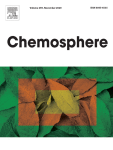Ver ítem
- xmlui.general.dspace_homeCentros Regionales y EEAsCentro Regional Buenos Aires SurEEA BalcarceArtículos científicosxmlui.ArtifactBrowser.ItemViewer.trail
- Inicio
- Centros Regionales y EEAs
- Centro Regional Buenos Aires Sur
- EEA Balcarce
- Artículos científicos
- Ver ítem
Atrazine uptake, translocation, bioaccumulation and biodegradation in cattail (Typha latifolia) as a function of exposure time
Resumen
The extensive use and environmental persistence of atrazine has resulted in its ubiquitous occurrence in water resources. Some reports have described atrazine bioaccumulation and biodegradation pathways in terrestrial plants, but few have done so in aquatic macrophytes. Thus, in this study, we aimed to analyze morphological changes, uptake, translocation and bioaccumulation patterns in tissues of the aquatic macrophyte Typha latifolia (cattail) after
[ver mas...]
The extensive use and environmental persistence of atrazine has resulted in its ubiquitous occurrence in water resources. Some reports have described atrazine bioaccumulation and biodegradation pathways in terrestrial plants, but few have done so in aquatic macrophytes. Thus, in this study, we aimed to analyze morphological changes, uptake, translocation and bioaccumulation patterns in tissues of the aquatic macrophyte Typha latifolia (cattail) after long-term atrazine exposure and to determine the presence of atrazine biodegradation metabolites, desethylatrazine (DEA) and desisopropylatrazine (DIA), in tissues. Plants were hydroponically exposed to 20 μg/L atrazine (18 exposed and 18 non-exposed) for 7, 14, 21, 28, 35 and 42 days. Plants were separated into root, rhizome, stem, and lower, middle and upper leaf sections. Atrazine was analyzed by LC-MS/MS and DIA and DEA by LC-DAD. Plants showed reductions in weight (after 21 days) and transpiration (after 28 days), both symptoms of chronic phytotoxicity. The distribution of atrazine within tissues, expressed as concentration levels (μg/kg dry weight), was as follows: middle leaf (406.10 ± 71.77) = upper leaf (339.15 ± 47.60) = lower leaf (262.43 ± 7.66) = sprout (274.53 ± 58.1) > stem (38.63 ± 7.55) = root (36.00 ± 3.49) = rhizome (26.15 ± 3.96). In submerged tissues, DEA and DIA were detected at similar concentrations. In leaves, DIA was the main metabolite identified. Results indicated that atrazine was taken up from roots to shoots and induced phytotoxicity effects that reduced the translocation to shoots. Typha likely is able to biodegrade atrazine via different metabolic pathways.
[Cerrar]

Autor
Pérez, Débora Jesabel;
Doucette, William Joseph;
Moore, Matthew Truman;
Fuente
Chemosphere 287, Part 1: 132104 (January 2022)
Fecha
2021-08-30
Editorial
Elsevier
ISSN
0045-6535
Documentos Relacionados
Formato
pdf
Tipo de documento
artículo
Proyectos
(ver más)
INTA/2019-PD-E2-I039-002/2019-PD-E2-I039-002/AR./REMEDIACIÓN DE SUELOS Y AGUAS Y RESTAURACIÓN ECOLÓGICA DE SISTEMAS DEGRADADOS POR USO AGROPECUARIO, AGROINDUSTRIAL Y ACTIVIDADES EXTRACTIVAS
Palabras Claves
Derechos de acceso
Restringido
 Excepto donde se diga explicitamente, este item se publica bajo la siguiente descripción: Creative Commons Attribution-NonCommercial-ShareAlike 2.5 Unported (CC BY-NC-SA 2.5)
Excepto donde se diga explicitamente, este item se publica bajo la siguiente descripción: Creative Commons Attribution-NonCommercial-ShareAlike 2.5 Unported (CC BY-NC-SA 2.5)

